Ashtanga Hridayam sutrasthana chapter 11 explains in detail about Tridosha in Ayurveda. Tridosha are – Vata, Pitta and Kapha. Understanding the Tridosha concept is your first step towards learning Ayurveda. The chapter is called Doshadi Vijnaneeya Adhyaya.
Dehasya Mulam – Chief constituents of the body
Dosha Dhatu Mala moolam..


Dosha – Vata, Pitta and Kapha
Dhatu – Body tissues – Rasa (lymph/product of digestion), Rakta (blood), Mamsa (muscle), Meda (fat), Asthi (bone), Majja (bone marrow), and Shukra (male and female reproductory secretions)
Mala – waste products – sweat, urine, and faeces Doshas, are the roots of the body. 1.
Functions of normal Doshas – Prakruta Dosa Karma
Prakrut Vata Dosha Karma – Functions of Vata Dosha
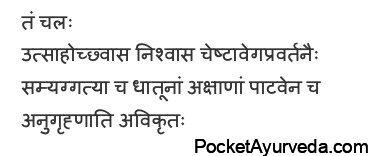

Vata is responsible for all movements. (Movement of blood in blood vessels, movement of nutrients, movement of air in lungs, locomotion movements of hands and legs, etc. )
In its normal state, Vata causes enthusiasm, Vata Dosha regulates the respiration process, Regulates all locomotor movements, Regulates all activities of mind, speech, initiation of natural urges (tears, faeces, urination, sneezing, coughing, vomiting yawning, etc) maintenance of the Dhatus (tissues) in their normalcy and proper functioning of the sense organs.
Prakrita Pitta Dosha Karma – Functions of Pitta Dosha


In its normal state, Pitta causes digestion and metabolism Maintenance of body temperature, vision, Causes hunger, thirst, and appetite, and Maintains skin complexion, intelligence, courage, valor, and softness (suppleness) of the body.
Kapha Dosha Karma – Functions of Kapha Dosha


Kapha confers stability, lubrication, and compactness (firmness) of the joints, Kshama – It is the cause of the mental capacity to withstand or withhold emotions, strains, etc. It is also cause for forgiveness 11⁄2 – 3.
Prakrita Dhatu Mala Karma – Functions of body tissues –Functions of body tissues and waste products


Rasa Dhatu (product of digestion and metabolism) – provides nourishment
Rakta (blood) – maintenance of life activities,
Mamsa (muscle) – enveloping (covering) – it covers around bones and enables voluntary and involuntary actions
Meda (fat) – lubrication,
Asthi (bones) – support, forms the framework of the body
Majja (bone marrow) – filling the inside of the bones
Shukra (male and female reproduction system)- conception and pregnancy.
Prakrut Mala Karma – Functions of waste products


Maintenance of strength of the body is the chief function of faeces; Elimination of moisture (water) is of urine, and Slow elimination of moisture is of the sweat. 5.
Vriddha Dosha Karma – Effects of increased Doshas
Vata Vriddhi Lakshana – Effects of increased Vata Dosha


Vata, when increased produces Karshya – emaciation, Karshnya – black discoloration, Ushnakamitva – desire for hot things, Kampa – tremors Anaha – bloating, fullness, distention of the abdomen, Shakrut Graha – constipation,
Bala bhramsha – loss of strength,
Nidra bhramsha – loss of sleep Indriya bhramsha – loss of sensory functions, Pralapa – irrelevant speech,
Bhrama – Delusion, Dizziness giddiness Deenata – timidity (peevishness). 51⁄2 – 6.
Pitta Vriddhi Lakshana – Effects of increased Pitta Dosha


Pitta, when increased, produces yellow discoloration of the faeces, urine, eyes, and skin; excess hunger and thirst, feeling of burning sensation and very little sleep.6 1⁄2.
Kapha Vriddhi Lakshana – Effects of increased Kapha Dosha


Kapha, when increased produces Agnisadana – weak digestive activity, Praseka – excess salivation,
Alasya – lassitude, laziness Gaurava – feeling of heaviness,
Shvaithya – white discoloration,
Shaithya – coldness,
Shlathangatva – the looseness of the body parts, Shwasa – dyspnoea, asthma, COPD Kasa – cough, cold
Atinidrata – excess of sleep. 7 – 71⁄2.
Dhatu Vruddhi Lakshana – Effects of increased body tissues
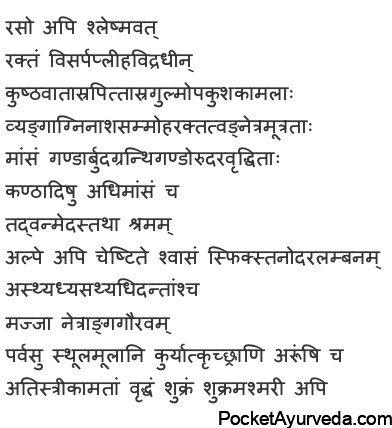

Rasa when increased in similar to Kapha, produces the same symptoms of increased Kapha;
Rakta (blood) when increased produces Visarpa – Herpes, spreading skin disease, Pleeha – diseases of the spleen,
Vidradhi – abscesses, Kushta – skin diseases Vatasra – gout
Pittasra – bleeding disease, Gulma – abdominal tumors, Upakusa – a disease of the teeth,
Kamala – jaundice,
Vyanga – discolored patch on the face,
Agninasha – loss of digestion strength
Sammoha – Coma, unconsciousness,
Red discoloration of the skin, eyes, and urine. 8 – 9.
Mamsa (muscle tissue), when increased produces
Ganda – cervical lymphadenitis
Granthi – tumor,
Increase in size of the cheeks, thighs, and abdomen,
overgrowth of muscles of the neck and other places 9 – 91⁄2.
Medas (fat tissue), when produces similar symptoms, and in addition, it causes fatigue, difficulty in breathing even after little work, and drooping of the buttocks, breasts, and abdomen. 91⁄2 – 10.
Asthi (bone tissues), when increased causes overgrowth of bones and extra teeth. 101⁄2.
Majja (marrow), when increased produces heaviness of the eyes and the body, increases of the size of the body joints, and causes ulcers which are difficult to cure. 101⁄2 – 111⁄2.
Shukra (semen) when increased produces great desire for the woman (sexual desire) and seminal calculi (spermolith). 12.
Mala Vriddhi Lakshana – Effects of increased waste products
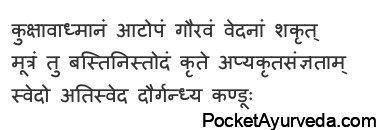

Shakrit (feaces), when increased causes distension of the abdomen, gurgling noise, and a feeling of heaviness. 121⁄2
Mutra (urine), when increased produces severe pain in the bladder and a feeling of non-elimination even after urination. 13
Sweda (sweat) when increased produces excess perspiration, foul smell, and itching. 131⁄2


The increase of Dushika (excretion of the eyes) and other waste products is to be understood by their increased quantity, heaviness (of their sites), and other symptoms. 14.
Dosha Kshaya Lakshana – Functions of decreased Doshas – Ksheena Doshakarma
Vata Kshaya Lakshana – Decreased Vata Dosha symptoms


Angasada – debility of the body,
Alpa bhashite hitam – the person speaks very little
Sanjna moha – loss of sensation (awareness) and of consciousness and occurrence of all the symptoms of increased Kapha.
Pitta Kshaya Lakshana – Decreased Pitta Dosha Symptoms


Mande anala – weakness of digestive activity, Shaitya – coldness
Prabha hani – loss of luster (complexion). 151⁄2.
Kapha Kshaya Lakshana – Decreased Kapha Dosha Symptoms


Bhrama – Delusion, Dizziness,
Shunyatva – emptiness of the organs of Kapha, hrudrava – tremors of the heart (palpitation) Shlatha sandhita – looseness of the joints. 16.
Dhatu Kshaya Lakshana – Symptoms of decreased Dhatu (body tissues)
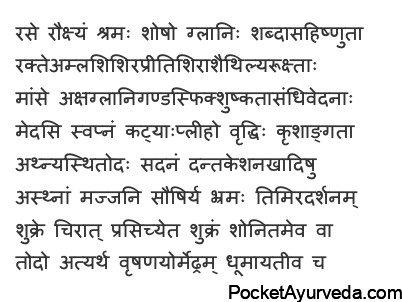

Decrease of Rasa dhatu produces dryness, fatigue, emaciation, exhaustion without any work and noise intolerance.
Decrease of Rakta produces desire for sour and cold things, loss of tension of veins (and arteries) and dryness. 17.
Decrease of Mamsa causes debility of the sense organs, emaciation of cheeks, buttocks and pain in the joints. 171⁄2.
Decrease of Medas causes loss of sensation in the waist, enlargement of spleen and emaciation of the body. 18.
Decrease of Asthi causes pain in the joints, falling off of the teeth, hairs, nails etc. 181⁄2.
Decrease of Majja causes hollowness (of the bones inside) giddiness and seeing of darkness 19.
Decrease of Shukra results in delay in ejaculation, ejaculation accompanied with bleeding, severe pain in the testicles and a feeling of hot fumes coming out of the urethra. 20.
Mala Kshaya Lakshana – Symptoms of decreased waste products
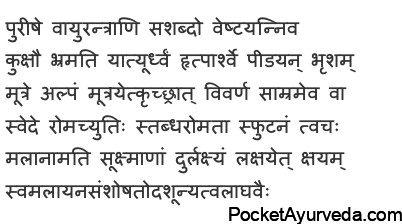

Decrease of faeces gives rise to gurgling noise in the intestines and bloating, vata moves in an upward direction in the intestine causing discomfort and pain in the region of the heart and flanks. 21.
Decrease of urine causes scanty urination, dysuria, urine discoloration or hematuria. 211⁄2.
Decrease of sweat leads to falling of hair, stiffness of hair, and cracking of the skin. 22.
Decrease of Malas which are of little quantity is difficult to perceive, it should be inferred from the dryness, pricking pain, emptiness, and tightness of their sites of production and elimination. 23.
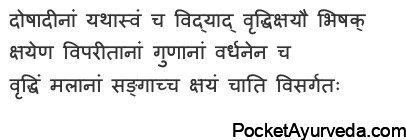

The decrease of Dosha Dhatu etc can be observed by the increase of opposite qualities. The increase of Dosha Dhatu etc can be observed by the increase of similar qualities.
The increase of Malas is observed by their non-elimination (too much waste product accumulation leading to obstruction) and their decrease by too much elimination in little quantities. 231⁄2 – 241⁄2.


The body is accustomed to the accumulation of waste products (in the intestines and bladder), and the decrease of waste product formation is more troublesome than their increase. 25.
Relationship between Dosha and Dhatu


Vata resides in Asthi (bones)
Pitta resides in Sweda (sweat) and Rakta (blood)
Kapha resides in the rest of the Dhatu and Mala.
In case of Pitta and Kapha, when there is an increase of Pitta or Kapha, there is also a respective increase of tissues and waste products associated with them.
For example, if Pitta increases, then sweat and blood vitiation also increase. The same rule applies to decrease as well.
But in the case of Vata, if Vata decreases, then Asthi increases. They are inverse-proportionately related with each other. 26 – 27.
Cause for increase or decrease of Dosha
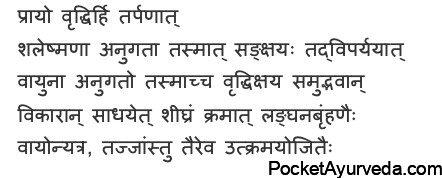

The increase of Doshas, Dhatus, and Mala is usually due to excess nutrition (Tarpana), which is followed later on by an increase of Kapha.
Whereas the decrease in Doshas, Dhatus, and Malas is due to loss of nutrition which is followed, later by the increase of Vayu (Vata).
Hence, the diseases arising from the increase of Dosha and Dhatu should be usually treated quickly by adopting Langhana (therapy causing thinning of the body, reducing the quantity)
The diseases arising from the decrease of Dosha and Dhatu should be treated with Brimhana therapy (causing stoutening the body, increasing the quantity, etc.)
But in the case of Vata, the order is reversed. If Vata is increased, then Brihmana therapy (nourishing therapy) should be adopted and if Vata decreases then Langhana therapy should be adopted. 28 – 29.
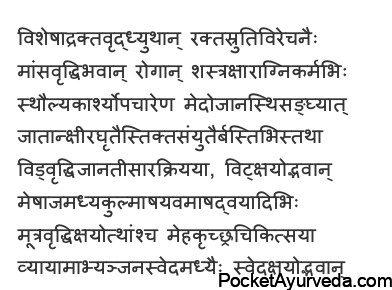

In particular, the disease arising from – an increase of rakta should be treated with- bloodletting and Purgations.
Increase of mamsa is treated by use of – sharp instruments (surgery), caustic alkalies, and, fire cautery.
Increase of medas is treated by therapies indicated for obesity, and decrease by therapies indicated for emaciation.
Decrease of asthi is treated by enema therapy using – a. milk, b. ghee and, c. bitter drugs (Tikta Dravya)
Increase of vit / feces is treated by the use of – a. abdominal viscera of ram or goat, b. half steamed pulses, c. barley, and, d. the two varieties of Masha, etc. as food.
Increase and decrease of mutra / urine – By adopting treatments indicated for diabetes and dysuria respectively.
Decrease of sveda / sweat is treated by adopting – a. physical exercises, b. oil bath, c. sudation therapies and d. use of wine.
Kayagni and Dhatwagni
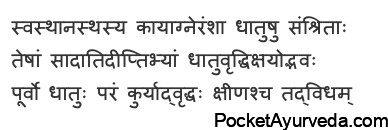

Kayagni present in its own place, has portions of itself, present in the dhatus also.
Their decrease in qualities, quantities or functions gives rise to increase and decrease of dhatus respectively. The proceeding dhatu which is either increased or decreased gives rise to the succeeding dhatu of the same condition.
Dusta Dosha Karma – Effects of vitiated Doshas


The Doshas which are vitiated [become abnormal undergoing either increase or decrease] cause vitiation of the Rasa and other Dhatus (tissues) next;
Both Doshas and Dhatus together vitiate the Malas (waste products) which in turn, vitiate the Malayanas (channels of their elimination).
Malayana – routes of elimination of waste products are –
two below – anus and urethra, seven in the head, and
the channels of sweat; from these vitiated channels develop their connected diseases. 341⁄2 – 36.
Ojas – the essence of Dhatus
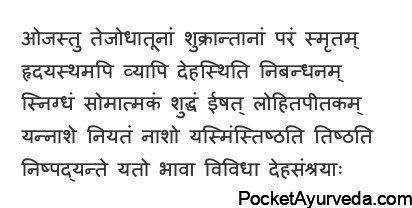

Ojas is the essence of the Dhatus;
It is mainly located in the heart. It is present all over the body and regulates health.
Qualities of Oja
Snigdha – unctuous, oily
Somatmaka – watery
Shuddha – clear (transparent),
Ishat Lohita Peetakam – slight reddish yellow in colour; Loss of Ojus leads to loss of life. All aspects of health are related to Ojas.
Ojas Kshaya Lakshana – Cause for decrease of Ojas
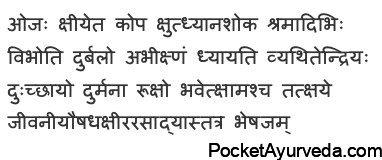

Ojas undergo a decrease in quantity by anger, hunger (starvation), worry, grief, exertion, etc.,
Symptoms of Ojas decrease –
The person becomes fretful, debilitated, repeatedly worries without any reason, feels discomfort in sense organs, develops a bad complexion, negative thoughts, and dryness;
Treatment of oja kshaya
Use of drugs of Jeevaniya group (Enlivening) (mentioned in chapter 15) milk, meat juice etc. 39 – 40.
Notes :- Many more causes of the decrease of Ojas have been mentioned in other texts of Ayurdeva, they are
Ativyayama – too much exercise
Anashana – fasting for long periods of time Alpasana – eating fewer quantities of food
Rooksapana (intake of alcoholic beverages which cause dryness),
Pramitasana (intake of a mixture of good and bad foods),
Bhaya (fear),
Prajagara (waking up at night),
Abhighata (injury),
Abhishanga (assault by evil spirits; micro organisms like bacteria, virus etc.), Dhatukshaya (depletion of tissues such as by haemorrhage etc.),
Ativisarga (too much elimination) of Kapha, Sonita (blood), Sukra (semen), and Mala (waste products);
Visha (ingestion of poison)
Oja Vriddhi Lakshana – Increase of Ojas


Increase of Ojas makes for contentment, nourishment of the body, and increase of strength. 41.


The increase of Doshas should be controlled by avoidance of foods that are disliked.
The decrease in Doshas should be managed by the food indulgence that is desired. 42.


The Doshas which have undergone increase and decrease generally produce a desire for foods that are dissimilar and similar (in properties to those of the Doshas) respectively, but the unintelligent person does not recognize them. 43.


The Doshas, when increased produce their respective features (signs and symptoms) depending upon their strength; when decreased they do not produce signs and symptoms and when normal, they attend to their normal functions. 44.


The very same Doshas, which when normal, are the causes for the growth of the body, become the causes for its destruction when abnormal.
Hence by adopting suitable measures, the body should be protected from their decrease and increase 45.
Thus ends the chapter called Doshadi Vijnaneeya Adhyaya.
FAQ’s of Doshadi Vijnaniya Adhyaya
Which are the chief constituents of the body?
Dosha, Dhatu and Mala
what are the normal functions of vata dosha?
all movements, enthusiasm regulates the respiration, locomotor movements, Regulates all activities of mind, speech, initiation of natural urges, maintenance of the Dhatus and proper functioning of the sense organs.
what are the normal functions of pitta dosha?
digestion and metabolism Maintenance of body temperature, vision, Causes hunger, thirst, and appetite, and Maintains skin complexion, intelligence, courage, valor, and softness (suppleness) of the body
what are the normal functions of kapha dosha?
stability, lubrication, and compactness (firmness) of the joints, mental capacity to withstand or withhold emotions, strains, etc. It is also caused for forgiveness
what are the normal functions of dhatu?
Rasa Dhatu – nourishment
Rakta – maintenance of life activities,
Mamsa –covers around bones and enables voluntary and involuntary actions
Meda – lubrication,
Asthi – support, forms the framework of the body
Majja – filling the inside of the bones
Shukra – conception and pregnancy.what are the normal functions of mala?
Maintenance of strength of the body is the chief function of faeces; Elimination of moisture (water) is of urine, and Slow elimination of moisture is of the sweat.
what are the vata vriddhi lakshana?
Karshya, Karshnya, Ushnakamitva, Kampa, Anaha, Shakrut Graha
Bala bhramsha, Nidra bhramsha, Indriya bhramsha, Pralapa,
Bhrama, Deenata.what are the pitta vriddhi lakshana?
yellow discoloration of the faeces, urine, eyes, and skin, excess hunger and thirst, feeling of burning sensation and very little sleep.
what are the kapha vriddhi lakshana?
Agnisadana,Praseka, Alasya,Shvaithya,Shaithya,Shlathangatva,Shwasa, Gaurava,Kasa,Atinidrata.
what are the vata kshaya lakshana?
Angasada, Alpa bhashite hitam,Sanjna moha – loss of sensation (awareness) and of consciousness and occurrence of all the symptoms of increased Kapha.
what are the pitta kshaya lakshana?
Mande anala – weakness of digestive activity, Shaitya – coldness, Prabha hani – loss of luster (complexion).
what are the kapha kshaya lakshana?
Bhrama, Shunyatva, hrudrava, Shlatha sandhita.
what is Ojas?
Ojas is the essence of the Dhatus
what is the location of ojas?
It is mainly located in the heart. It is present all over the body and
what are the causes of oja kshaya?
anger, hunger (starvation), worry, grief, exertion, etc.
what are the symptoms of oja kshaya
debilitated, repeatedly worries without any reason, feels discomfort in sense organs, develops a bad complexion, negative thoughts, and dryness
what is the treatment for oja kshaya?
Jeevaniya group (Enlivening) (mentioned in chapter 15) milk, meat juice etc.




